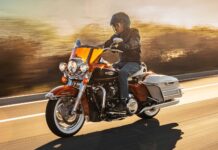For over 40 years people have been asking me to teach them how to ride a motorcycle, and as a result I have schooled dozens of such supplicants, some of whom are still with us today thanks in large measure to my careful instruction and the miracle of respirators. With a track record like that it comes as small surprise that I’m also frequently asked by experienced riders for my advice on the instruction of beginners, especially at this time of year when the arrival of spring brings a fresh crop of newbies, and thus for all of you who find yourselves similarly badgered I’ve devised the following simple three-step program for successful education in the motorcycling arts. I hope it helps.
Step I—Thinning the Herd
When a prospective protégé comes to you to request guidance in the motorcycling arts, you must first ask yourself this fundamental question: Should this person even be on a motorcycle? Generally the answer to this will be an emphatic NO! and you should save the misguided youth a lot of time and expense by just killing them outright. If, however, you deem the person to have the necessary coordination, common sense and funds to make a go of it, you should ask yourself a second fundamental question: Do I want to teach this person? In addressing this pivotal issue you must decide three things: 1) Do you want this person going on runs with you, because, sure as hell, that’ll be their next request. 2) Does this person have the “right stuff”—by which I mean a motorcycle you won’t be embarrassed to be seen with? 3) Does this person have breasts?
If you can honestly respond in the affirmative to all three considerations you may have found a qualified candidate—but in all likelihood you’re just kidding yourself.
Step II—Pre-flight Instruction
Once you’ve evaluated the aptitude of the applicant and found them up to snuff, it’s time to slowly and patiently go over the operating features of the machine. Keep in mind that they are new to this and things that are obvious to you, the seasoned rider, are mysterious and confusing to the novice. My usual introduction to the controls goes like this:
“Gas…clutch…shifter…brakes. Got it? No? What’s your problem? Are you stupid? Well, are you? Look at me when I’m talking to you! I said Are you stupid? Maybe you’re not cut out for this. Maybe roller skates are more your speed. You’re wasting my time. Call me when you grow some brains.”
Now that you’ve completed the basic operational instruction, it’s time to elaborate the subtle interplay between the various controls, stressing the balance between their functions: Clutch, shift, gas, go, stop… clutchshiftgasgostop… clutchshiftgasgostop—have the student chant this sequence like a mantra while holding an image of the procedures in their mind’s eye. Have them close their eyes and continue repeating it while you mock them silently and pretend to lick their face. This is the true joy of teaching.
What I usually suggest at this point in the curriculum is that before starting the bike, the student should spend a good solid hour just practicing. What they should be practicing is just falling over. From a stationary position have them fall over on the right side and then the left. Have them do this repeatedly until they’ve smashed the turn signals, mirrors, levers, pipes and anything else that would normally be demolished under novice usage. I find that the student’s attention to riding will be much more focused once they’ve stopped worrying about falling down and wrecking all that shiny stuff. Let’s face it, they’re going to do it anyway so they might as well get it out of the way early.
Step III—The Moving Experience
Now that the novice rider has been thoroughly browbeaten and their machine has been thoroughly trashed, it’s time to let them actually try to ride the thing. Have them start the motor, pull in the clutch, step it into first, roll the throttle on and gently engage the clutch. What happens next is a complete mystery to me since I’ve never had the stomach to watch. I usually retreat to the house, draw the drapes and turn up the stereo to drown out any annoying screams or sirens.
If your student somehow survives this step in the course of instruction, you should proceed by teaching them to maneuver the bike at slow speeds. To facilitate this lesson, it’s handy to have a few of those orange cone deals to set up in a slalom course. If you don’t have any of those things—and why would you?—you can take the pupil out to a highway construction zone where they usually have some already set up. Have the pupil practice weaving gracefully through the cones and around the guys standing about like statues leaning on shovels. Continue this drill until the student gets backed over by a grader or scooped up in the bucket of a skip-loader. Not only does this improve their maneuvering skills, it also gives them an appreciation for how vulnerable and insignificant they are on the highway.
Once the student has become proficient at slow-speed maneuvering, your job is pretty much finished. You have technically taught them to ride a motorcycle, and by god that’s all you ever said you’d do. Besides, when all’s said and done, it will be the novice’s innate ability and desire that will dictate how quickly and how well they learn to ride. Ultimately your role is one of nurturing; to direct and empower them with the voice of experience. That’s all they really need to hear, and it’s a damn sight more than I got when I learned to ride. The first time I rode a motorcycle the only thing I heard was, “Hey! Stop! Come back with my bike you damn thief!”
It’s all right here in the diaries.




















